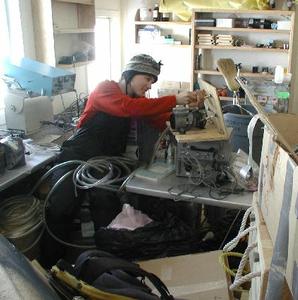9 December, 2001
Weather report: The trip to CONZ was postponed this morning due to
weather. We really expected that no work would get done today. Wind
chills were in the eighty-below range. But the weather did break, and the
afternoon was 23 degrees below zero (C) with very little wind.
I left out one chapter in the SMELLING portion of investigating
volcanoes--our windows into the active earth--by leaving out the research
of Jessie Crain. (She has been mentioned other times in this
journal.) This research involves the installation of pumps that pull
gases from the plume. But the gases being filtered out are not the ones
mentioned yesterday. They are radioactive.
Radioactive decay is a process by which one element changes into another
element--not by chemical change, but by becoming fundamentally
differennt. Sometimes the change takes thousands of years, sometimes less
than a second. By this process, Uranium can go through multiple changes
and wind up as lead. Some of the chemicals in this chain are very
different than the chemicals that produced them. A metal, for example,
might give rise to a gas. Jessie's work involves capturing one element in
this chain of reaction that exists for less than a month. Since this
element is produced as a gas, it bubbles up out of the magma chamber at a
known speed. By measuring how much of the gas is left, some indication of
the depth of the magma chamber can be deduced. Interesting Note:
Jessie's samples are taken from our camp by helicopter to McMurdo, where
they are placed on the next plane for New Zealand, then FedExed to Paris
where they are analyzed.
Today I got a first hand look at the installation of instruments that FEEL
the volcano. This is the science of seismometry. Most people are
familiar with seismometers (seismographs) as they are used to detect the
shaking of the earth during an earthquake. Seismometry can be related to
the medical model of learning much as we saw with looking, or seeing. You
can feel the earth shake during an earthquake, and you can feel the earth
shake during a volcanic eruption, but seismomters look deeper, just like
doctors look deeper with X-rays. Sound and pressure waves travel
differently through solids and fluids, so when there is an eruption event,
seismometers can detect differences in speed that offer a unique look into
the make-up of the magma chamber. Where is the fluid? Where is the solid
rock? What is the shape, depth, and size of the magma chamber? These are
the questions being addressed by seismometry.
Today, we took another trek to the top of the mountain carrying heavy gear
to install a seismometer on the rim of the crater. Science can be very
hard work, especially when climbing at high altitudes. The installation
was a success. But something else happened--the volcano erupted three
times while we were there! Before you wonder why I can still be here
typing this, you should know that not all eruptions are the same. This
was not an explosive type of eruption (although Erebus does do that
frequently). These were gas eruptions. Suddenly, and lasting for about a
minute, the floor of the crater would erupt with a thunderous hiss, and
clouds of yellowish vapor were thrust up into the atmosphere. Very
impressive.
Final item: Please e-mail me if you have questions about the kinds of
work being described so far. If you want to know more, or if you don't
understand--ask!

Jessie Crain, hard at work preparing the gas pumps that will collect samples on the rim of the crater.

Here I am preparing to bury a seismomter. First I level it, then carefully cover it. It detects the slightest shaking of the earth. That's Mt. Terror in the background--an extinct volcano.

This is a view of one of the lava lakes on the floor of the crater. On very clear days, you can see the red lava in the pit. My friend Dr. Jeff Johnson (who I was helping with the installation process) believes that this is the vent that erupted while we were working.
Contact the TEA in the field at
.
If you cannot connect through your browser, copy the
TEA's e-mail address in the "To:" line of
your favorite e-mail package.
|
